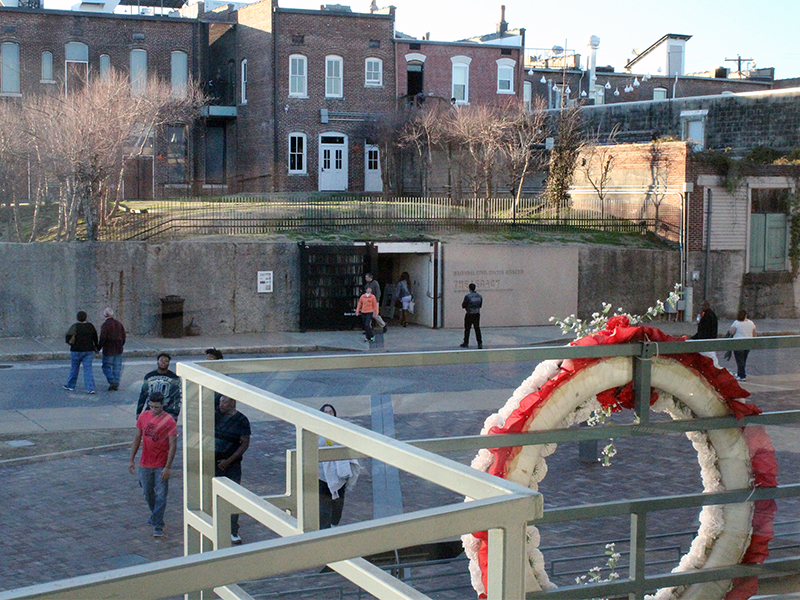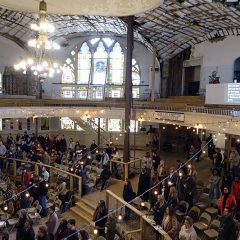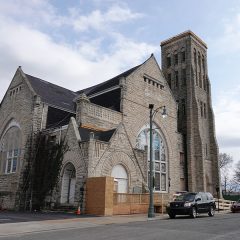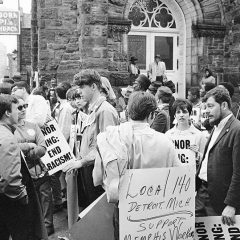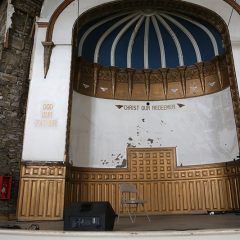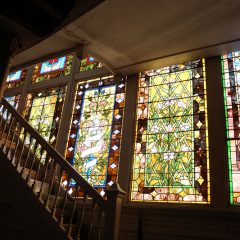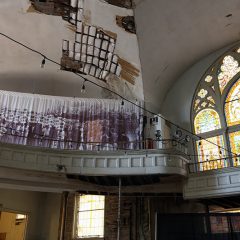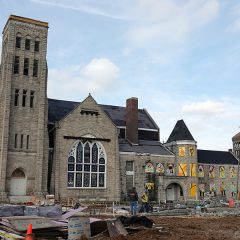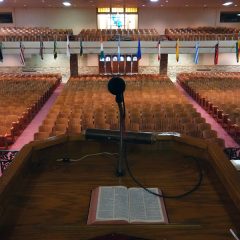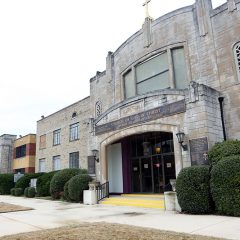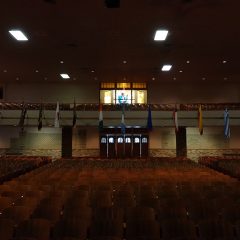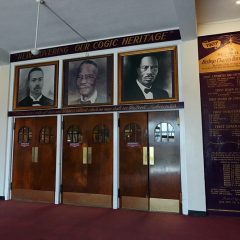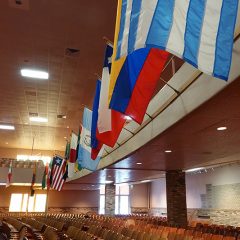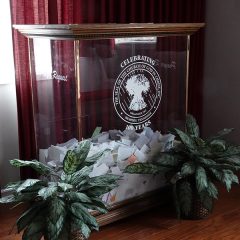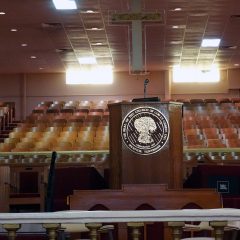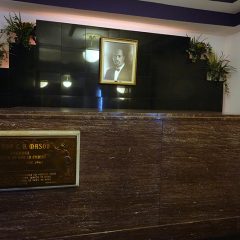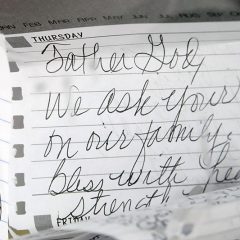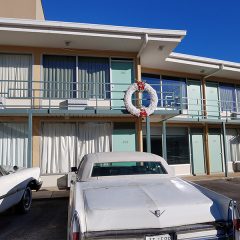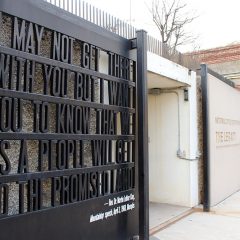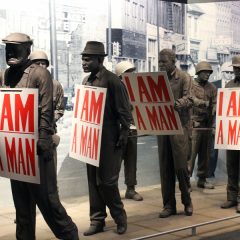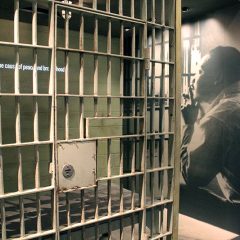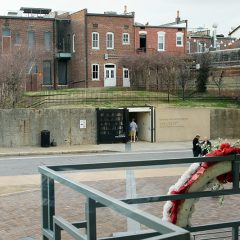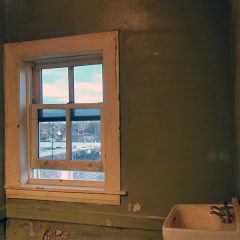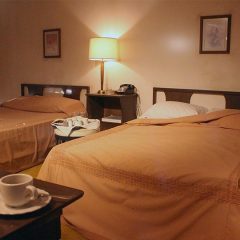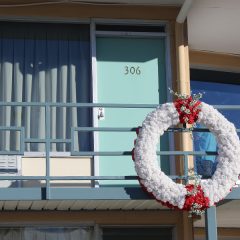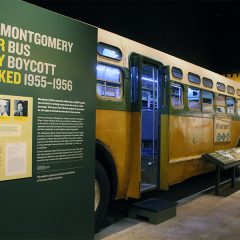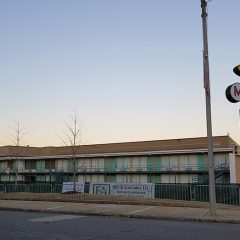Religion News Service is marking the 50th anniversary of the assassination of the Rev. Martin Luther King Jr. with stories and commentaries looking back at the tragic, momentous event. The rest of the package can be found here.
MEMPHIS, Tenn. (RNS) — Within close proximity of each other in downtown Memphis sit three historic buildings — two of them houses of worship — crucial to the legacy of the Rev. Martin Luther King Jr.
All three, which are part of the U.S. Civil Rights Trail, are seeing an influx of visitors as people in the city — and far beyond it — mark the 50th anniversary of the two-month strike by black sanitation workers and other events that led up to his assassination.
[ad number=“1”]
Clayborn Temple
Built in 1891, the Romanesque building — now outfitted with folding chairs instead of pews — was the site from which King led a March 28, 1968, protest with the sanitation workers.
The laborers met in the building, their wives and children stayed there while they marched, and the iconic “I Am a Man” signs were printed in the basement and distributed from there. After the protest turned violent, some of the marchers sought shelter there. But the police sprayed tear gas into the sanctuary and some of the church’s stained-glass windows were broken.
- The Downtown Church, a diverse congregation that meets weekly in the historic Clayborn Temple in Memphis, Tenn., gathers for worship on Feb. 11, 2018. The church is being used again after decades of disrepair. RNS photo by Karen Pulfer Focht
- Clayborn Temple was one of the hubs of activity for the civil rights movement in Memphis, Tenn. It is where the “I Am a Man” signs were distributed. RNS photo by Karen Pulfer Focht
- People gather at Clayborn Temple as they prepare to march in honor of the Rev. Martin Luther King Jr. in Memphis, Tenn., on April 8, 1968, four days after the civil rights leader was assassinated. Shuttered for years, Clayborn Temple is returning to glory as one of the most significant buildings associated with the civil rights movement in the South. (AP Photo)
- Clayborn Temple was one of the hubs of activity for the civil rights movement in Memphis, Tenn. It is where the “I Am a Man” signs were distributed. RNS photo by Karen Pulfer Focht
- Although Clayborn Temple was not used for many years, the historic building experienced very little vandalism, according to Deondra Henderson, operations manager for Clayborn Reborn. RNS photo by Karen Pulfer Focht
- Deondra Henderson, operations manager for Clayborn Reborn, at Clayborn Temple in Memphis, Tenn., on March 5, 2018. RNS photo by Karen Pulfer Focht
- The “I Am a Man” signs of the Memphis, Tenn., sanitation strike were handed out at Clayborn Temple. RNS photo by Karen Pulfer Focht
- Repairs and improvements are being made around Clayborn Temple in March 2018. RNS photo by Karen Pulfer Focht
The building was first the home of predominantly white Second Presbyterian Church and then a predominantly black African Methodist Episcopal congregation and was abandoned for about two decades. Clayborn Reborn, a joint project of a leadership foundation and a neighborhood preservation group, is working to renovate the building, which now houses the interracial Downtown Church. It also hosts events ranging from concerts to Rotary Club meetings.
The original ornate chandelier continues to hang from a ceiling with massive gaps in the plaster due to water damage from rain. Hundreds of pipes are missing from the organ. When its disrepair was at its worst, the church remained a sanctuary for homeless people, drug addicts and cats. There are stories of squatters holding church services there, said Deondra Henderson, operations manager for Clayborn Reborn.
“During the abandonment of Clayborn we only had three graffiti markings inside of this entire building and there was no vandalism done to the exterior of the building,” she said. “So the building really does demand a respect because of its history and because of its sacredness.”
Planners hope to maintain it as “a safe space for dangerous conversations,” Henderson said, noting that marches still leave from its doors, including one last Feb. 12 honoring the striking sanitation workers and seeking a higher minimum wage.
[ad number=“2”]
Mason Temple
The site of the headquarters of the Church of God in Christ still holds the wooden pulpit from which King gave his final “I’ve Been to the Mountaintop” sermon.
Above its 3,700 red cushioned seats are colorful flags of some of the dozens of countries in which there are congregations of the nation’s largest black Pentecostal denomination, founded by Bishop Charles H. Mason more than a century ago.
- The Rev. Martin Luther King Jr. gave his final sermon from this pulpit at Mason Temple on April 3, 1968, the night before he was assassinated in Memphis, Tenn. RNS photo by Karen Pulfer Focht
- The Rev. Martin Luther King Jr. gave his final sermon at Mason Temple on April 3, 1968, the night before he was assassinated in Memphis, Tenn. RNS photo by Karen Pulfer Focht
- Mason Temple is the world headquarters of the Church of God in Christ. It features dozens of national flags representing where the denomination has churches. RNS photo by Karen Pulfer Focht
- The entrance to Mason Temple features past leaders of the Church of God in Christ in Memphis, Tenn. RNS photo by Karen Pulfer Focht
- Mason Temple is the world headquarters of the Church of God in Christ. It features dozens of national flags representing where the denomination has churches. RNS photo by Karen Pulfer Focht
- A prayer request box inside Mason Temple in Memphis, Tenn. RNS photo by Karen Pulfer Focht
- Mason Temple is the world headquarters of the Church of God in Christ. The Rev. Martin Luther King Jr. gave his final sermon from this pulpit on April 3, 1968. RNS photo by Karen Pulfer Focht
- The tomb of Bishop Charles Harrison Mason, the founder of the Church of God in Christ, at Mason Temple in Memphis, Tenn. RNS photo by Karen Pulfer Focht
- Prayer requests at Mason Temple in Memphis, Tenn. RNS photo by Karen Pulfer Focht
When it was completed in the 1940s, it was considered to be one of the largest church buildings owned by a predominantly black denomination in the United States.
“This building was built as a meeting place where they could come together for spiritual renewal and training and enlightenment,” said Lesa Clayton, executive assistant for COGIC national properties. “And the saying is that Bishop Mason received from God that he would never be able to build a building that would be large enough to hold the Church of God in Christ.”
In fact, in 2010, after long having its Holy Convocation at this location, COGIC moved the annual meeting to St. Louis. Other gatherings, including annual business meetings and its Founder’s Celebration — honoring Mason, who is entombed in the building — continue to be held at Mason Temple.
Though it is not a local church, it is viewed as a place of “fasting and prayer,” Clayton said. There are plexiglass prayer request boxes under the large pulpit and in an adjoining chapel.
Although King is one of the most well-known speakers who graced its pulpit, others have included then-President Bill Clinton, who addressed a 1993 Holy Convocation, and then-Sen. Hillary Clinton, who spoke there during the 2008 presidential campaign. In early March, Rep. John Lewis, D-Ga., a longtime civil rights activist, included Mason Temple as a stop on a bipartisan congressional pilgrimage of the Faith and Politics Institute.
[ad number=“3”]
Lorraine Motel/National Civil Rights Museum
The black-run Lorraine Motel was the last place King met, strategized and joked with fellow civil rights activists before his death. The motel, with its original yellow, red and white sign, features a wreath on the balcony outside Room 306.
Though the museum features a broad sweep of African-American history — including a Montgomery, Ala., bus similar to the one where Rosa Parks stayed seated — its display of two rooms where King and other activists were staying on April 4, 1968, draws lines of people.
- A memorial wreath hangs on the Lorraine Motel balcony where the Rev. Martin Luther King Jr. was assassinated in Memphis, Tenn. The former motel is now part of the National Civil Rights Museum. RNS photo by Adelle M. Banks
- The National Civil Rights Museum addresses a broad swath of African-American history, including many lesser-known heroes and everyday people who influenced the civil rights movement. The life and work of the Rev. Martin Luther King Jr. make up roughly one-quarter of the museum’s coverage. RNS photo by Adelle M. Banks
- An exhibit about the Memphis sanitation strike at the National Civil Rights Museum in Memphis, Tenn. RNS photo by Adelle M. Banks
- An exhibit on the Rev. Martin Luther King Jr.’s letter from the Birmingham Jail at the National Civil Rights Museum in Memphis, Tenn. RNS photo by Adelle M. Banks
- A memorial wreath and plaque at the Lorraine Motel balcony where the Rev. Martin Luther King Jr. was assassinated in Memphis, Tenn. The former motel is now part of the National Civil Rights Museum. RNS photo by Adelle M. Banks
- The view from the Lorraine Motel balcony where the Rev. Martin Luther King Jr. was killed, facing the boardinghouse where the gunman stayed. The properties are now part of the National Civil Rights Museum in Memphis, Tenn. RNS photo by Adelle M. Banks
- The same window that was there in 1968 is in the bathroom from where a gunman assassinated the Rev. Martin Luther King Jr. The historic boardinghouse building is now part of the National Civil Rights Museum in Memphis, Tenn. RNS photo by Adelle M. Banks
- Room 306 of the Lorraine Motel is a reconstruction of what the room looked like on April 4, 1968, when the Rev. Martin Luther King Jr. was killed. It is now part of the National Civil Rights Museum in Memphis, Tenn. RNS photo by Adelle M. Banks
- A memorial wreath hangs on the Lorraine Motel balcony where the Rev. Martin Luther King Jr. was assassinated in Memphis, Tenn. The former motel is now part of the National Civil Rights Museum. RNS photo by Adelle M. Banks
- An exhibit on the Montgomery bus boycott in Alabama at the National Civil Rights Museum in Memphis, Tenn. RNS photo by Adelle M. Banks
- The Lorraine Motel, where the Rev. Martin Luther King Jr. was assassinated in Memphis, Tenn., is now part of the National Civil Rights Museum. RNS photo by Adelle M. Banks
Room 306, reconstructed in 1982, features two beds, one with the spread pulled down just below a pillow. Dishes and salt and pepper shakers sit on a table next to the bed. A cup of coffee, a small milk carton and two ashtrays filled with cigarette butts are near the television.
Leaning over the balcony just outside the room, King had asked a musician to play “Precious Lord,” one of his favorite hymns, at a meeting planned for that evening. He was shot at 6:01 p.m. and pronounced dead at 7:05 p.m.
As tourists move toward Room 306, they can look out a window past the wreath on the balcony across the street to the partially open bathroom window of the boardinghouse from which the assassin’s bullet was released. “Dr. King never uttered a word after being shot,” reads the display in front of the room.
A gallery just preceding those rooms is devoted to the sanitation workers’ strike, with a 1960s-era sanitation truck, on which a loop of short video clips shows the protests and King voicing his Southern Christian Leadership Conference’s support of the strikers. Just beyond the room where King stayed is an area detailing the global mourning over his death and the settlement of the sanitation workers’ strike two weeks later.
The museum continues across the street in the boardinghouse and the building next door to it. Two floors of exhibits record a timeline of events prior to King’s assassination and the investigation into his death. Visitors can walk by the bathroom from which investigators say James Earl Ray fired the fatal shot and can enter an adjoining room to see the view of the Lorraine Motel from the boardinghouse.
An exhibit that includes questions such as “Did Ray Have Help?” and “Did Someone Else Do It?” also states: “What is certain is that King’s final months and days as a foot soldier in the movement were shadowed.”
Though the buildings have drawn special attention as organizers plan events to mark the 50th anniversary of King’s assassination, Pastor Linwood Dillard, leader of a Church of God in Christ congregation in Memphis, said the site has long attracted people who want to honor King.
“Sometime my parents would just take us by just to see the spot where Dr. King was slain,” the 40-year-old minister recalled of a childhood tradition that continues for others today. “It was just a place of remembrance. You’ll see people walking through, just paying homage and just reflecting on Dr. King’s life and legacy.”
